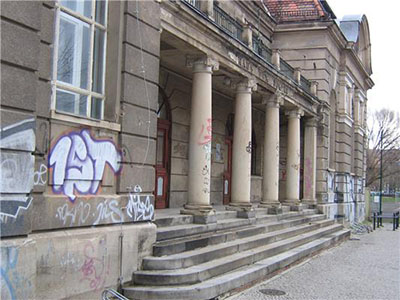Sep 10 2009
Many a historic landmark is defaced with graffiti, but the spray paint can only be removed – if at all – using caustic solutions which risk damaging the underlying surface. A new breathable coating provides efficient, all-round protection against attacks by taggers.

It takes seconds to spray on graffiti, but hours or weeks to remove – especially from porous natural stone or brickwork as found in the majority of historic monuments. The paint penetrates deep into the pores from which it is impossible to remove, even with a pressure hose or multi-component solvents. Often the only answer, other than living with the graffiti, is to etch away a part of the wall. Special anti-graffiti polymer coatings have been on the market for several years. They create a hydrophobic seal that closes the pores, preventing the paint from adhering to the undersurface and allowing it to be wiped off. But as a result the building can no longer breathe, augmenting the risk of mold development or salt efflorescence. Because they cannot be removed easily, such coatings also run counter to the principles of conservation, which require that any changes must be reversible.
“There are conflicting requirements for this kind of polymer coating – it mustn’t seal the pores, because it is important that there should be a continuous exchange of air between the building and the external environment, and at the same time it has to prevent the spray paint from penetrating the pores. The coating needs to be sufficiently resistant to withstand both weathering and mechanical cleaning. Moreover, since we’re dealing with historic landmarks, it must be possible to completely remove the coating from the walls if required, to restore them to their original condition with little effort and without damaging the structure,” says Professor André Laschewsky, who heads the relevant research group at the Fraunhofer Institute for Applied Polymer Research IAP in Potsdam.
As part of an EU-sponsored project, Laschewsky’s team and partners from the Center of Polymer and Carbon Materials of the Polish Academy of Sciences in Gliwice and Zabrze have developed a polymer coating that meets these requirements. “Our innovative polymer film seals the pores in the substrate, so that graffiti paint doesn’t penetrate. But its micro-porous structure also creates a hydrophobic barrier that allows water vapor to escape from the building while at the same time preventing the infiltration of rainwater,” says Laschewsky. The coating can be removed from the surface using a diluted brine solution which modifies its chemical composition and allows it to be washed off. Coordinated by the LABEIN Foundation in Spain and the german Federal Institute for Materials Research and Testing the partners have coated samples of ancient stone and brick and repeatedly covered them with graffiti – which was removed completely each time.